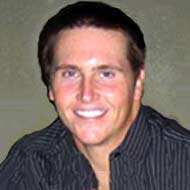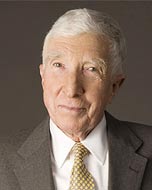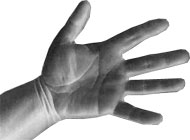News and Site Updates Archive 2009/01/31
Mere factual innocence is no reason not to carry out a death sentence properly reached.
- US Supreme Court Justice Antonin Scalia
Herrera versus Collins 506 US 390 1993
31 Jan '09 -
Australia has lately produced a wealth of amazing research on bees. For example: bees taught to
respond to the first and last photos above are able to interpolate that the middle photo is of the same person and respond to it as well. Bee brains contain fewer than 1 million neurons (their
brains are 0.01% the size of the human brain) but they are nevertheless very good at mastering complex
tasks. In another test: bees were able naturally to tell the difference
between patterns containing 2 and 3 dots – and with a bit of schooling could distinguish between 3 and 4. Scientists will next test whether bees can perform basic arithmetic.
 Constitutional Originalist Antonin Scalia's parsing on torture: "Torture isn't
'cruel and unusual punishment' because the subject hasn't been convicted of a crime, so he can't be 'punished.'" Or how about
this? "I think when the Constitution says that persons are entitled to equal protection of
the laws, I think it clearly means walking-around persons." [Indelicate phrasing, surely.] And
finally, "You know, justices retire at full salary. So there's no reason not to leave and go off and do something else. So essentially I've been working for free, which probably means I'm
too stupid to be on the Supreme Court." Click image to enlarge... "No one who has a taste for literature has the right to be happy because the only men entitled to happiness are those who are
useful." - Richard Teller Crane, Industrialist, 1911. (I wonder if Richard subscribes to Justice Scala's contention that equal protection under the law is reserved for "walking around"
persons - except perhaps he would have said "working around" persons?)... Intimate partner
violence — abuse by a spouse or significant other — affects approximately 25 - 33% of women in the United States. [Can this really be true? That sounds impossibly high.] Further, higher
than expected numbers of complex cheekbone fractures, cracks or breaks in bones surrounding the eye and brain were found in intimate partner violence victims while victims assaulted by unknown or
unidentified assailants were more likely to have jaw fractures. Constitutional Originalist Antonin Scalia's parsing on torture: "Torture isn't
'cruel and unusual punishment' because the subject hasn't been convicted of a crime, so he can't be 'punished.'" Or how about
this? "I think when the Constitution says that persons are entitled to equal protection of
the laws, I think it clearly means walking-around persons." [Indelicate phrasing, surely.] And
finally, "You know, justices retire at full salary. So there's no reason not to leave and go off and do something else. So essentially I've been working for free, which probably means I'm
too stupid to be on the Supreme Court." Click image to enlarge... "No one who has a taste for literature has the right to be happy because the only men entitled to happiness are those who are
useful." - Richard Teller Crane, Industrialist, 1911. (I wonder if Richard subscribes to Justice Scala's contention that equal protection under the law is reserved for "walking around"
persons - except perhaps he would have said "working around" persons?)... Intimate partner
violence — abuse by a spouse or significant other — affects approximately 25 - 33% of women in the United States. [Can this really be true? That sounds impossibly high.] Further, higher
than expected numbers of complex cheekbone fractures, cracks or breaks in bones surrounding the eye and brain were found in intimate partner violence victims while victims assaulted by unknown or
unidentified assailants were more likely to have jaw fractures.
 The Clinton administration let the government of Israel's then-Prime Minister Ehud Barak
determine the direction and pace of Arab-Israeli peace negotiations. Barak often seemed to treat
Clinton and his aides in a remarkably peremptory fashion. The apotheosis was Clinton's abortive meeting with Syrian President Hafez al Assad in Geneva in March 2000. Undertaken at Barak's
insistence, Clinton later complained to the Israeli prime minister that the meeting made him feel "like a wooden Indian sitting there doing your bidding"... President George W Bush's
final approval rating was the lowest final rating for an outgoing president since Gallup began
asking about presidential approval more than 70 years ago. His rating was far below the final ratings of recent 2-term presidents Bill Clinton and Ronald Reagan, who both ended their terms with 68%
of those polled approving of them. Recent 1-term presidents also had higher ratings than Bush. His father had an end-of-term rating of 54%, while Jimmy Carter's rating was 44%. Harry
Truman had previously held the record for lowest end-of-term approval at 32%. Vice President Dick Cheney also left office amid negative perceptions, as his approval rating stood at just
13%... A waiter asks a man, "May I take your order, sir?" "Yes," the man replies. "I'm just wondering, exactly how do you prepare your chicken?" "Nothing special, sir. We
just tell 'em straight out that they're gonna die." The Clinton administration let the government of Israel's then-Prime Minister Ehud Barak
determine the direction and pace of Arab-Israeli peace negotiations. Barak often seemed to treat
Clinton and his aides in a remarkably peremptory fashion. The apotheosis was Clinton's abortive meeting with Syrian President Hafez al Assad in Geneva in March 2000. Undertaken at Barak's
insistence, Clinton later complained to the Israeli prime minister that the meeting made him feel "like a wooden Indian sitting there doing your bidding"... President George W Bush's
final approval rating was the lowest final rating for an outgoing president since Gallup began
asking about presidential approval more than 70 years ago. His rating was far below the final ratings of recent 2-term presidents Bill Clinton and Ronald Reagan, who both ended their terms with 68%
of those polled approving of them. Recent 1-term presidents also had higher ratings than Bush. His father had an end-of-term rating of 54%, while Jimmy Carter's rating was 44%. Harry
Truman had previously held the record for lowest end-of-term approval at 32%. Vice President Dick Cheney also left office amid negative perceptions, as his approval rating stood at just
13%... A waiter asks a man, "May I take your order, sir?" "Yes," the man replies. "I'm just wondering, exactly how do you prepare your chicken?" "Nothing special, sir. We
just tell 'em straight out that they're gonna die."
    |
|
David Smith, 31 (above), lost a
whopping 28 stone in 2 years, then had more than 30 pounds of excess skin surgically removed. As a result, he is currently a fitness coach and has met his first girlfriend. (Yes,
you can do it, too.)
|
  Sunset over the Pacific
photographed by an Expedition 15 crewmember on the International Space Station... I love lenticular
clouds. Sometimes, when wind comes off a mountain or hill, relatively strong vertical oscillations take place as the air stabilises. The air at the top of an oscillation may be quite
stratified in moisture content and separate clouds form at each layer giving the whole thing a stacked look. I've seen several beautiful examples in New Zealand. Click image to
enlarge... Physicists assume that any black holes created by the Large Hadron Collider will decay via Hawking radiation. It should be of concern that Hawking radiation has never been seen nor
tested, and the fundamental theory behind Hawking radiation has been questioned in 2 recent peer-reviewed physics papers. If black holes are created and do not decay,
we could have problems. Since this scenario is speculative it
might be appropriate to assign it a moderately low subjective probability. However, standard expected value calculations (probability times cost) result in an enormous negative expected value when
the cost at issue is the loss of Earth. Sunset over the Pacific
photographed by an Expedition 15 crewmember on the International Space Station... I love lenticular
clouds. Sometimes, when wind comes off a mountain or hill, relatively strong vertical oscillations take place as the air stabilises. The air at the top of an oscillation may be quite
stratified in moisture content and separate clouds form at each layer giving the whole thing a stacked look. I've seen several beautiful examples in New Zealand. Click image to
enlarge... Physicists assume that any black holes created by the Large Hadron Collider will decay via Hawking radiation. It should be of concern that Hawking radiation has never been seen nor
tested, and the fundamental theory behind Hawking radiation has been questioned in 2 recent peer-reviewed physics papers. If black holes are created and do not decay,
we could have problems. Since this scenario is speculative it
might be appropriate to assign it a moderately low subjective probability. However, standard expected value calculations (probability times cost) result in an enormous negative expected value when
the cost at issue is the loss of Earth.
  Serotonin plays an important role as a neurotransmitter in the modulation of anger,
aggression, body temperature, mood, sleep, human sexuality, appetite, and metabolism as well as stimulating vomiting. The psychedelic drugs psilocin/psilocybin, DMT, mescaline, and LSD mimic the
action of serotonin. The empathogen MDMA (ecstasy) releases serotonin. Low levels of serotonin may also be associated with intense spiritual experiences. Serotonin as a neurotransmitter
is found in all animals, including insects. Several toad venoms, as well as that of the Brazilian wandering spider and stingray, contain
serotonin. A recent paper in Science even suggests a causal link between
serotonin levels and how one perceives fairness (lower levels of serotonin can make life seem unfair). It has also been identified as
the trigger for swarm behaviour in locusts (and makes them go from juvenile green to crusty brown). Dates,
papayas, bananas, bright sunlight and being a muscular male can increase brain levels. (Since high levels - up to a point - increase self-confidence and arrogance and since sun and muscles increase
levels, then male lifeguards at the beach must be at their life's apex.) Serotonin plays an important role as a neurotransmitter in the modulation of anger,
aggression, body temperature, mood, sleep, human sexuality, appetite, and metabolism as well as stimulating vomiting. The psychedelic drugs psilocin/psilocybin, DMT, mescaline, and LSD mimic the
action of serotonin. The empathogen MDMA (ecstasy) releases serotonin. Low levels of serotonin may also be associated with intense spiritual experiences. Serotonin as a neurotransmitter
is found in all animals, including insects. Several toad venoms, as well as that of the Brazilian wandering spider and stingray, contain
serotonin. A recent paper in Science even suggests a causal link between
serotonin levels and how one perceives fairness (lower levels of serotonin can make life seem unfair). It has also been identified as
the trigger for swarm behaviour in locusts (and makes them go from juvenile green to crusty brown). Dates,
papayas, bananas, bright sunlight and being a muscular male can increase brain levels. (Since high levels - up to a point - increase self-confidence and arrogance and since sun and muscles increase
levels, then male lifeguards at the beach must be at their life's apex.)

 Researchers in Germany put a bunch of people aged about 60 on a diet that cut calorie intake by up to
30%. Another group had a diet high in unsaturated fatty acids – foods like olive oil and fish thought to be linked to memory – while a 3rd control group was on a normal diet. In the human
test, the group on the restricted-calorie diet showed an increase in verbal memory scores whereas the other two groups did not. Moral: too much food dims your mental powers. (I wonder why they
didn't try a low-carb diet as well while they were about it)... By giving their cows names and treating
them as individuals, farmers can increase annual milk yields by almost 500 pints per head. Just as people respond better to the personal touch, cows also feel happier and more relaxed if they are
given one-to-one attention. By placing more importance on the individual animal, calling a cow by her name and interacting with her more (understanding her personality), the farmer improves her life
and gets her to trust humans. The cow responds by giving the farmer more milk... Individuals with the so-called
"warrior gene" display higher levels of aggression in response to provocation. Monoamine oxidase A is an enzyme that
breaks down important neurotransmitters in the brain, including dopamine, norepinephrine, and serotonin. The enzyme is regulated by the monoamine oxidase A gene (MAOA). Humans have various
forms of the gene, resulting in different levels of enzymatic activity. Several studies have found a correlation between the low-activity form of MAOA and aggression. This has potentially
important implications for interpersonal aggression, violence, political decision-making, and crime.
Researchers in Germany put a bunch of people aged about 60 on a diet that cut calorie intake by up to
30%. Another group had a diet high in unsaturated fatty acids – foods like olive oil and fish thought to be linked to memory – while a 3rd control group was on a normal diet. In the human
test, the group on the restricted-calorie diet showed an increase in verbal memory scores whereas the other two groups did not. Moral: too much food dims your mental powers. (I wonder why they
didn't try a low-carb diet as well while they were about it)... By giving their cows names and treating
them as individuals, farmers can increase annual milk yields by almost 500 pints per head. Just as people respond better to the personal touch, cows also feel happier and more relaxed if they are
given one-to-one attention. By placing more importance on the individual animal, calling a cow by her name and interacting with her more (understanding her personality), the farmer improves her life
and gets her to trust humans. The cow responds by giving the farmer more milk... Individuals with the so-called
"warrior gene" display higher levels of aggression in response to provocation. Monoamine oxidase A is an enzyme that
breaks down important neurotransmitters in the brain, including dopamine, norepinephrine, and serotonin. The enzyme is regulated by the monoamine oxidase A gene (MAOA). Humans have various
forms of the gene, resulting in different levels of enzymatic activity. Several studies have found a correlation between the low-activity form of MAOA and aggression. This has potentially
important implications for interpersonal aggression, violence, political decision-making, and crime.
 |
 |
|
Absorbed sunlight is balanced by heat radiated from Earth’s surface and atmosphere. This satellite map shows
the distribution of thermal infrared radiation emitted by Earth in September 2008. Most heat
escaped from areas just north and south of the equator, where the surface was warm but there were few clouds. Along the equator, persistent clouds prevented heat escaping. Likewise, the
cold poles radiated little heat. What I want to know: is the equator cooler than the latitudes immediately northward and southward? Presumably the cloud cover would prevent its absorbing
heat as well as preventing heat radiation. That isn't something I would have expected. |
"How to Repaint a Jumbo Jet in 3 Minutes" (Comments section): Paint adds weight so
American Airlines uses just silver metal skin. Airplanes should never carry more than 2 layers of paint else operating efficiency drops, inspections are made harder and corrosion starts in
chips remaining under a fresh topcoat. Excessive paint buildup makes inspection of rivet rows and lap splices connecting fuselage panels more difficult. Maintaining appearances of
polished airplanes requires repolishing up to 3x a year when a special compound is applied with mechanical buffers and regular washing cleans oxidation buildup from unpainted surfaces; this requires
considerable investment in buffing equipment and personnel. Periodic maintenance can be done during repolishing, though not while a painted airplane is being stripped and
repainted. While the lighter weight of a polished airplane saves fuel costs, this savings is more than offset by the higher care costs. Net excessive operating cost of polished airplanes
is .06% - .30% more than that of fully painted planes. Both must be washed regularly to preserve exterior surfaces, but for appearance it is common for polished planes to be washed twice as
often. However, this gives maintenance personnel an opportunity to closely inspect surface conditions, allowing better prediction of future maintenance requirements. Painted surfaces are
susceptible to filiform (worm) corrosion between metallic surfaces and paint, eroding both and creating hydrogen that lifts the paint. |
 The agency that
operates New York City's major airports said it has a multimillion-dollar program to chase birds off its property, but can only do so much to protect planes once they are in the air. The Port
Authority of New York and New Jersey said it kills 1,000s of birds every year in the marshy waterways and tidal flats that surround its 2 major airports in Queens, and uses guns, pyrotechnics and hawks to
drive away birds. Among the other tactics: bird eggs are coated in oil to prevent them from hatching and nests are removed. The agency also plays recordings of bird distress calls, and
landscapers remove shrubs and trees that might be attractive to certain species. Sometimes aircraft have to take evasive action to avoid flocks of geese. Other times, it's too late and they
can only hope for the best... The pilot of US Airways Flight 1549, Chesley "Sully" Sullenberger, could hardly have been better prepared. The 58-year-old former fighter pilot was
named best aviator in his class at the Air Force Academy, had flown for US Airways for 29 years, mastered glider flying, and has investigated air disasters (even studying how airline crews should behave
in crises). The goal when landing in water is to set the plane down gently to keep it from breaking apart and sinking rapidly. Pilots aim to slow a plane without stalling (dropping abruptly)
and to keep the wings level. Drag a wing tip into a wave and the plane might overturn. If the landing gear is down, the wheels will catch in the water, which also might flip the
plane. Pilots also risk tearing up the fuselage if they plow headlong into waves... Nearly ¾ of
college-aged American males play video games regularly. By comparison, just 17% of their female counterparts play more than once a month... The smallest possible interval of time is the
Planck length divided by the speed of light. The agency that
operates New York City's major airports said it has a multimillion-dollar program to chase birds off its property, but can only do so much to protect planes once they are in the air. The Port
Authority of New York and New Jersey said it kills 1,000s of birds every year in the marshy waterways and tidal flats that surround its 2 major airports in Queens, and uses guns, pyrotechnics and hawks to
drive away birds. Among the other tactics: bird eggs are coated in oil to prevent them from hatching and nests are removed. The agency also plays recordings of bird distress calls, and
landscapers remove shrubs and trees that might be attractive to certain species. Sometimes aircraft have to take evasive action to avoid flocks of geese. Other times, it's too late and they
can only hope for the best... The pilot of US Airways Flight 1549, Chesley "Sully" Sullenberger, could hardly have been better prepared. The 58-year-old former fighter pilot was
named best aviator in his class at the Air Force Academy, had flown for US Airways for 29 years, mastered glider flying, and has investigated air disasters (even studying how airline crews should behave
in crises). The goal when landing in water is to set the plane down gently to keep it from breaking apart and sinking rapidly. Pilots aim to slow a plane without stalling (dropping abruptly)
and to keep the wings level. Drag a wing tip into a wave and the plane might overturn. If the landing gear is down, the wheels will catch in the water, which also might flip the
plane. Pilots also risk tearing up the fuselage if they plow headlong into waves... Nearly ¾ of
college-aged American males play video games regularly. By comparison, just 17% of their female counterparts play more than once a month... The smallest possible interval of time is the
Planck length divided by the speed of light.
 According to a
phenomenon known as the Baldwin effect, characteristics learned or developed over a lifespan may, over many
generations, become gradually encoded in the genome since organisms with a stronger predisposition to acquire a useful trait would have a selective advantage. Over time, the amount of
environmental exposure required to develop the trait will decrease; eventually no environmental exposure is needed and the trait has become genetically encoded. An example is the development of
calluses on the keels and sterna of ostriches. These may initially have developed in response to abrasion where the keel and sterna touch the ground during sitting. Natural selection favours
individuals that develop calluses more rapidly, until callus development is triggered within the embryo and occurs without environmental stimulation. But
consider the incest taboo in this light. If powerfully enforced, this removes the natural selection pressure against the
possession of incest-favouring genes. After a few generations without this pressure, unless such genetic material is profoundly fixed in the genome, it tends to diversify and lose
function. Humans would no longer be innately averse to incest, but would rely on their capacity to internalise such rules from cultural practices. [Hence religion?] This draws a
comparison to the naturalist Jean-Baptiste Lamarck, who is remembered primarily for a theory of "inheritance of acquired characters",
called "soft" inheritance or Lamarckism. However, his descriptions of soft inheritance were, in fact, reflections of the folk wisdom of the time, accepted by most natural historians (including
Charles Darwin in his Origin of Species). Lamarck's main contribution was the first cohesive theory of evolution in which an "alchemical complexifying force" drives organisms toward
complexity while an "environmental force" adapts them to a locale through "use and disuse" of potential characteristics. According to a
phenomenon known as the Baldwin effect, characteristics learned or developed over a lifespan may, over many
generations, become gradually encoded in the genome since organisms with a stronger predisposition to acquire a useful trait would have a selective advantage. Over time, the amount of
environmental exposure required to develop the trait will decrease; eventually no environmental exposure is needed and the trait has become genetically encoded. An example is the development of
calluses on the keels and sterna of ostriches. These may initially have developed in response to abrasion where the keel and sterna touch the ground during sitting. Natural selection favours
individuals that develop calluses more rapidly, until callus development is triggered within the embryo and occurs without environmental stimulation. But
consider the incest taboo in this light. If powerfully enforced, this removes the natural selection pressure against the
possession of incest-favouring genes. After a few generations without this pressure, unless such genetic material is profoundly fixed in the genome, it tends to diversify and lose
function. Humans would no longer be innately averse to incest, but would rely on their capacity to internalise such rules from cultural practices. [Hence religion?] This draws a
comparison to the naturalist Jean-Baptiste Lamarck, who is remembered primarily for a theory of "inheritance of acquired characters",
called "soft" inheritance or Lamarckism. However, his descriptions of soft inheritance were, in fact, reflections of the folk wisdom of the time, accepted by most natural historians (including
Charles Darwin in his Origin of Species). Lamarck's main contribution was the first cohesive theory of evolution in which an "alchemical complexifying force" drives organisms toward
complexity while an "environmental force" adapts them to a locale through "use and disuse" of potential characteristics.
 The
FlightSuit allows birds to "enjoy more out-of-cage time without the
mess, inconvenience, and embarrassment of soiled clothing or furnishings." But if he sees himself in a mirror, your bird may never speak to you
again. British
middle-aged professionals are far more likely to be drinking too much than blue collar workers and the young. Some 43% of those in managerial and professional occupations, many of them women,
exceed healthy drinking limits, compared to 31% in routine and manual jobs; 22% of middle-class men and women had imbibed alcohol 5 times in the past week. Among those in the highest social
category - top managers and large employers - 49% of both men and women drank too much. More worryingly, 67% of professional women were most likely to do their drinking at
home... If left to the market, virtually the entire banking sector would be
bankrupt. Top executives would be sent packing - or at least have compensation (including "golden parachutes" and bonuses) set by bankruptcy judges who are running the companies in the
interest of creditors, not shareholders. Government has intervened in a huge way to keep the market from taking its course - but buried in debates in media and political circles is the separation of
the interest of the public in a functional financial system and the interests of bank executives in high salaries and shareholders in returns on capital. Bank executives and shareholders took big
risks that went bad. If rewarded with taxpayer handouts, they'll continue. The game becomes heads they win, tails we lose. Keep the financial system functioning, but do it without
transferring hundreds of billions of dollars from the middle class taxpayer to the country's wealthiest. If the bailout conditions imposed by the Obama administration and Congress don't effectively
eliminate shareholder wealth in bankrupt banks and bring compensation (in whatever form) of bank executives down to main street levels - then that fact could only be explained by corruption. The
FlightSuit allows birds to "enjoy more out-of-cage time without the
mess, inconvenience, and embarrassment of soiled clothing or furnishings." But if he sees himself in a mirror, your bird may never speak to you
again. British
middle-aged professionals are far more likely to be drinking too much than blue collar workers and the young. Some 43% of those in managerial and professional occupations, many of them women,
exceed healthy drinking limits, compared to 31% in routine and manual jobs; 22% of middle-class men and women had imbibed alcohol 5 times in the past week. Among those in the highest social
category - top managers and large employers - 49% of both men and women drank too much. More worryingly, 67% of professional women were most likely to do their drinking at
home... If left to the market, virtually the entire banking sector would be
bankrupt. Top executives would be sent packing - or at least have compensation (including "golden parachutes" and bonuses) set by bankruptcy judges who are running the companies in the
interest of creditors, not shareholders. Government has intervened in a huge way to keep the market from taking its course - but buried in debates in media and political circles is the separation of
the interest of the public in a functional financial system and the interests of bank executives in high salaries and shareholders in returns on capital. Bank executives and shareholders took big
risks that went bad. If rewarded with taxpayer handouts, they'll continue. The game becomes heads they win, tails we lose. Keep the financial system functioning, but do it without
transferring hundreds of billions of dollars from the middle class taxpayer to the country's wealthiest. If the bailout conditions imposed by the Obama administration and Congress don't effectively
eliminate shareholder wealth in bankrupt banks and bring compensation (in whatever form) of bank executives down to main street levels - then that fact could only be explained by corruption.
 John Updike
John Updike
Written shortly
prior to his death in
Jan 2009 at age 76
(via Stuff) |
Requiem
It came to me the other day:
Were I to die, no one would say,
"Oh, what a shame! So young, so full
Of promise - depths unplumbable!"
Instead, a shrug and tearless eyes
Will greet my overdue demise;
The wide response will be, I know,
"I thought he died a while ago."
For life's a shabby subterfuge,
And death is real, and dark, and huge.
The shock of it will register
Nowhere but where it will occur. |
The human mind is prone to essentialism — the intuition that living things house a hidden substance that gives form
and determines powers. Growing out of an early, vague idea that traits are "in the blood," such an essence became identified with those abstractions discovered by Gregor Mendel called genes, then
with the iconic double-helixed DNA - an invisible molecule accessible only to a white-coated priesthood. However, today for the price of a flat-screen TV, people can read their essence in a
printout. The effects of being brought up in a given family [nurture] are sometimes detectable in childhood, but tend to peter out by the time a child grows up. That is,
the reach of genes [nature] gets stronger as we age, not weaker. But perhaps our genes affect our
environments, which reciprocates. Young children, at the mercy of parents, are forced to adapt to a world not of their choosing. When older, however, they gravitate to more suitable
microenvironments. Some children naturally lose themselves in books, nature, or computers; others ingratiate themselves with jocks, goths, or church. Whatever genetic quirks incline a youth
toward one niche or another magnify over time as he develops those parts of himself that help him flourish in his chosen
worlds. We differ in intelligence because of a mutation-selection standoff. Unlike personality
where it takes all kinds to make a world, with intelligence, smarter is simply better. But intelligence depends on large brain networks and thrives in a properly nourished, healthy body. Many
genes engage to keep this system going; inevitably, mutations do creep in. Dopamine is the molecular
currency in brain circuits associated with wanting, getting satisfaction, and paying attention. The gene for one kind of dopamine receptor comes in several versions; some are associated with
"approach related" personality traits such as novelty and sensation seeking and extraversion. A gene for another kind of receptor comes in a version that makes its dopamine system less
effective. This type is associated with impulsivity, obesity and substance abuse. Still another gene, COMT, produces an enzyme that breaks down dopamine in the prefrontal cortex (home of
reasoning and planning). If your gene version produces less COMT, you may concentrate better but be jittery. When the connection between the ACTN3 gene and muscle types was discovered,
parents and coaches started swabbing children's cheeks to steer the ones with the fast-twitch variant into
sprinting and football. One scientists had a better idea: "Just line 'em up with their classmates for a race and see which ones are
fastest." Iron is required to synthesise both serotonin and dopamine and serotonin receptors are known
to regulate iron-carrying proteins. Thus anæmia may have a direct impact on anxiety, depression and obsessive-compulsive disorders.
 Loop Quantum Cosmology (LQC) is the first tangible application of the
theory Loop Quantum Gravity. It combines Einstein's theory of gravity with quantum mechanics. The Big Bang requires a singularity where gravity, temperature and the density of the universe
become infinite. General relativity fails to describe what happens then because it can't cope with infinity. But instead assume the fabric of space-time is woven from loops of gravitational
field lines. Zoom out far enough and space appears smooth - but a close look reveals that space comes in indivisible chunks, or quanta, 10-35 square metres in size. If LQC turns out
to be correct, our universe emerged from a pre-existing universe that first expanded (like ours) then contracted due to gravity. As all matter ultimately squeezed into a microscopic volume, it neared
the so-called Planck density, 5.1 × 1096 kilograms per cubic metre. Theory forbids reaching this density because an extraordinary repulsive force is evident in the fabric of space-time at densities
equivalent to compressing a trillion solar masses down to the size of a proton. At this point, the quanta can't be squeezed any more and outward force overcomes gravity causing the universe to
rebound - and keep expanding because of inertia - until gravity slows it. If proven - and LQC is is ready for testable predictions - the big bang will give way to the big bounce and we'll finally
know the quantum structure of space-time. Instead of a new universe emerging from an infinitely-dense point, it could be recycled, possibly through an eternal series with no beginning or end.
Loop Quantum Cosmology (LQC) is the first tangible application of the
theory Loop Quantum Gravity. It combines Einstein's theory of gravity with quantum mechanics. The Big Bang requires a singularity where gravity, temperature and the density of the universe
become infinite. General relativity fails to describe what happens then because it can't cope with infinity. But instead assume the fabric of space-time is woven from loops of gravitational
field lines. Zoom out far enough and space appears smooth - but a close look reveals that space comes in indivisible chunks, or quanta, 10-35 square metres in size. If LQC turns out
to be correct, our universe emerged from a pre-existing universe that first expanded (like ours) then contracted due to gravity. As all matter ultimately squeezed into a microscopic volume, it neared
the so-called Planck density, 5.1 × 1096 kilograms per cubic metre. Theory forbids reaching this density because an extraordinary repulsive force is evident in the fabric of space-time at densities
equivalent to compressing a trillion solar masses down to the size of a proton. At this point, the quanta can't be squeezed any more and outward force overcomes gravity causing the universe to
rebound - and keep expanding because of inertia - until gravity slows it. If proven - and LQC is is ready for testable predictions - the big bang will give way to the big bounce and we'll finally
know the quantum structure of space-time. Instead of a new universe emerging from an infinitely-dense point, it could be recycled, possibly through an eternal series with no beginning or end.
 When Detroit News reporter
Charlie LeDuff got a call about a body lying frozen in an abandoned building, he told police officers, who referred him to 911. When Detroit News reporter
Charlie LeDuff got a call about a body lying frozen in an abandoned building, he told police officers, who referred him to 911.
Tuesday
About 5pm: Charlie calls 911 and describes the body's whereabouts.
20 minutes later: Operator calls back asking for more specific directions.
Wednesday
4:43pm: Reporter calls 911, waits and is disconnected.
4:46pm: Calls again and explains that he called yesterday but body is still there.
4:55pm: Fire Department calls back for specific directions and reporter offers to meet them at the site.
5:00pm: Fire Department arrives and homicide department is called; recovery begins.
LeDuff found out about the body from an anonymous caller who said his friend had seen it. The caller's friend was an urban explorer who gets thrills rummaging through and photographing the ruins of
Detroit. It turns out that this explorer last week was playing hockey with a group of other explorers on the frozen waters that had collected in the basement of the building. None of the men
called the police, the explorer said. They, in fact, continued their hockey
game. Click image to enlarge.
 The Chatham Islands are at the eastern end of a
feature called the Chatham Rise — an underwater plateau stretching eastward from New Zealand’s South Island for about 1,000 kilometres. The relatively shallow depth of water over the rise combined
with its location at a subtropical front (a boundary where warm waters in the north mix with cold, sub-Antarctic waters to the south), make the area especially hospitable to phytoplankton blooms. The
pigments change the way the surface of the ocean reflects and absorbs sunlight, creating colourful swirls that trace the location of the bloom. Click image to enlarge. (While you're at it, you
could check out this incredible photo of the Milky Way.) On a peripherally-related note: if you think government is a
sclerotic monopoly that can count on high customer lock-in only thanks to inertia, a lack of alternatives, and insane entry barriers, perhaps you should
consider seasteading. To compete with governments on existing land, you have to win a war, an
election, or a revolution because there's no more uncolonised land. But there's still a virgin realm left covering 70% of the earth's surface. The purpose of the Seasteading Institute is to
figure out how to make aquatic homesteads a reality thus allowing people to build their own innovative forms of governance. Their ultimate goal is to create standards and blueprints that can be
easily adapted, allowing small communities to rapidly incubate and test new models of
self-rule. Sample seastead. It seems to me that any colony that far offshore
needs to be as self-sustaining as possible. Satellite maps of phytoplankton blooms could help locate sites where fish are abundant. Of course, that's only a tiny part of the challenges
settlers would have to face. The Chatham Islands are at the eastern end of a
feature called the Chatham Rise — an underwater plateau stretching eastward from New Zealand’s South Island for about 1,000 kilometres. The relatively shallow depth of water over the rise combined
with its location at a subtropical front (a boundary where warm waters in the north mix with cold, sub-Antarctic waters to the south), make the area especially hospitable to phytoplankton blooms. The
pigments change the way the surface of the ocean reflects and absorbs sunlight, creating colourful swirls that trace the location of the bloom. Click image to enlarge. (While you're at it, you
could check out this incredible photo of the Milky Way.) On a peripherally-related note: if you think government is a
sclerotic monopoly that can count on high customer lock-in only thanks to inertia, a lack of alternatives, and insane entry barriers, perhaps you should
consider seasteading. To compete with governments on existing land, you have to win a war, an
election, or a revolution because there's no more uncolonised land. But there's still a virgin realm left covering 70% of the earth's surface. The purpose of the Seasteading Institute is to
figure out how to make aquatic homesteads a reality thus allowing people to build their own innovative forms of governance. Their ultimate goal is to create standards and blueprints that can be
easily adapted, allowing small communities to rapidly incubate and test new models of
self-rule. Sample seastead. It seems to me that any colony that far offshore
needs to be as self-sustaining as possible. Satellite maps of phytoplankton blooms could help locate sites where fish are abundant. Of course, that's only a tiny part of the challenges
settlers would have to face.
|



1
2
3
-
On 15 October 1970, 2 years into construction of Melbourne's West Gate Bridge, tragedy
struck; the 112-metre span between piers 10 and 11 collapsed and fell 50 metres (164 feet) to the ground and water below killing 35 construction workers. Of those who perished
many were located beneath the structure in workers' huts which were crushed by the falling span. Others were working on and inside the girder when it fell. The whole
2,000-tonne mass plummeted into the Yarra River mud with an explosion of gas, dust and mangled metal that shook buildings hundreds of yards away. Homes were spattered with flying
mud. An explosion and fire followed. The collapse was due to failure of the structural design and to an unusual method of erection. On the day of the collapse there was a
difference in camber of 11.4 centimetres (4.5 inches) between 2 half girders at the west end of a span which needed to be joined. It was proposed that the higher one be weighted down
with 10 concrete blocks, each 8 tonnes, located onsite. The weight of these blocks caused the span to buckle (a sign of structural failure). The joining of the half girders was
partially complete when orders came through to remove the buckle. As bolts were removed the bridge snapped back and collapsed. Today, a death by suicide happens on the bridge
every 3 weeks; 7 have survived this fall.
-
A glance at a trader’s hand may reveal the size of his paycheque. The longer
his ring finger is when compared to his index finger, the bigger his pay is likely to be, a study of London traders found. The same ring-to-index finger ratio has previously been
associated with success in competitive sports such as soccer and basketball. The secret to prosperity may be contained in the digit ratio, which reflects the length of the index
finger divided by the length of the ring finger. The digit ratio indicates how much testosterone an unborn baby was exposed to in the womb. Those exposed to high levels are
more sensitive as adults to testosterone (which creates feelings of confidence, encourages risk-taking, search persistence, heightened vigilance and quickened reaction times). Men
typically have a ratio below 1, indicating their ring fingers are longer while women typically have a ratio of 1 or above.
-
US Congress is mulling a proposal to pay people to
get rid of their old gas guzzlers. Under the "Cash for Clunkers" program, drivers could get vouchers of up to $4,500 when they turn in old fuel-inefficient vehicles for
scrap and buy vehicles getting good gas mileage. Or they could instead turn in old cars for vouchers to ride public buses and trains. The bill envisions the program operating
for 4 years, encouraging the retirement of up to a million vehicles a year, saving 40,000 - 80,000 barrels of motor fuel a day by the end of the 4th year. Drivers must purchase a new
or used vehicle with a fuel economy rating exceeding federal targets for that class by at least 25%. It must have a manufacturer suggested retail price <$45,000 and be model year
2004 or later. Vehicles turned in must be drivable, registered in the US and have a when-new fuel economy rating <18 miles per gallon. In the first year, a person trading in
a vehicle model year 2002 and later would receive $4,500 for purchase of a new vehicle or $3,000 for purchase of a used vehicle or transit fare credit. For model year vehicles
1999 - 2001, drivers would get $3,000 for a new vehicle; 1998 or before could get a credit of $2,000.
|

 We’re in a post handwriting world, and no matter how nice it seems in theory, there just isn’t
a need to spend excessive time teaching a dying art. As long as people can read and write printed writing on some basic level what does it matter if their cursive skills aren't up to par? Time
is better spent on teaching more appropriate skills like touch typing, writing and critical thinking. All this said, perhaps handwriting will eventually come back into use as an analog throwback kind
of hobby, as seen in the craft movement of recent years. Two schools of thought: One - it won't matter if nobody learns handwriting because we all have computers; two - this is an interesting,
historic, valuable, and beautiful skill that has been around for thousands of years, and we are just thoughtlessly tossing it out (via
Psfk)... The location-aware future — good, bad, and sleazy — is here. Thanks to the iPhone 3G and to a
lesser extent Google's Android phone, millions of people are now walking around with a gizmo in their pocket that not only knows where they are but also plugs into the Internet to share that info, merge it
with online databases, and find out what — and who — is in the immediate vicinity. That old saw about how someday you'll walk past a Starbucks and your phone will receive a digital coupon for ½ off
on a Frappuccino? Yeah, that can happen now. Simply put, this one input — our coordinates — has the potential to change all the
outputs. Where we shop, who we talk to, what we read, what we search for, where we go — they all change
once we merge location and the web.
We’re in a post handwriting world, and no matter how nice it seems in theory, there just isn’t
a need to spend excessive time teaching a dying art. As long as people can read and write printed writing on some basic level what does it matter if their cursive skills aren't up to par? Time
is better spent on teaching more appropriate skills like touch typing, writing and critical thinking. All this said, perhaps handwriting will eventually come back into use as an analog throwback kind
of hobby, as seen in the craft movement of recent years. Two schools of thought: One - it won't matter if nobody learns handwriting because we all have computers; two - this is an interesting,
historic, valuable, and beautiful skill that has been around for thousands of years, and we are just thoughtlessly tossing it out (via
Psfk)... The location-aware future — good, bad, and sleazy — is here. Thanks to the iPhone 3G and to a
lesser extent Google's Android phone, millions of people are now walking around with a gizmo in their pocket that not only knows where they are but also plugs into the Internet to share that info, merge it
with online databases, and find out what — and who — is in the immediate vicinity. That old saw about how someday you'll walk past a Starbucks and your phone will receive a digital coupon for ½ off
on a Frappuccino? Yeah, that can happen now. Simply put, this one input — our coordinates — has the potential to change all the
outputs. Where we shop, who we talk to, what we read, what we search for, where we go — they all change
once we merge location and the web.
  Trooper
Greg Salier is one of 4 people on the Iowa state police force trained to use computers to investigate
accidents. When he plugs a car's Event Data Recorder ("black box" installed in most new cars) into his
computer, he finds out how fast that car was going in the seconds before an accident, if the car was accelerating, if the brakes were applied, and if the driver and passenger were wearing
seatbelts. "It's something else that helps me prove what happened," Trooper Salier said. "Sometimes I get a full 5 seconds prior to the collision." Critics argue that insurers want easy
access to black box data so they can use the information to set rates (rewarding good drivers and penalising bad ones) and to fight claims. They say the data can aid in proving fraud in
court. The controversy is just beginning - technology already allows for even more information to be recorded - and the black box cannot be disabled without compromising safety
features. Enhanced, it could even record the time and date of an accident and, using cell-phone technology, relay that information to police and emergency crews...
The first study to test real-world effects of stun gun use raises questions about safety. The rate of sudden deaths increased 6-fold in the first year that California law enforcement agencies
deployed the use of stun guns. There was also a 2-fold increase in the rate of firearm-related deaths during the same time period. Stun guns like the Taser deliver a high-frequency,
high-voltage current to disable victims by causing momentary neuromuscular incapacitation. They are in use by over 12,000 law enforcement, military and correctional agencies in the US and
abroad. If law enforcement agencies using Tasers understand the risks and are trained to recognise cardiac arrest, sudden death events can be averted with timely deployment of external fibrillation
or by knowing where not to apply the device’s current, such as near the heart. Trooper
Greg Salier is one of 4 people on the Iowa state police force trained to use computers to investigate
accidents. When he plugs a car's Event Data Recorder ("black box" installed in most new cars) into his
computer, he finds out how fast that car was going in the seconds before an accident, if the car was accelerating, if the brakes were applied, and if the driver and passenger were wearing
seatbelts. "It's something else that helps me prove what happened," Trooper Salier said. "Sometimes I get a full 5 seconds prior to the collision." Critics argue that insurers want easy
access to black box data so they can use the information to set rates (rewarding good drivers and penalising bad ones) and to fight claims. They say the data can aid in proving fraud in
court. The controversy is just beginning - technology already allows for even more information to be recorded - and the black box cannot be disabled without compromising safety
features. Enhanced, it could even record the time and date of an accident and, using cell-phone technology, relay that information to police and emergency crews...
The first study to test real-world effects of stun gun use raises questions about safety. The rate of sudden deaths increased 6-fold in the first year that California law enforcement agencies
deployed the use of stun guns. There was also a 2-fold increase in the rate of firearm-related deaths during the same time period. Stun guns like the Taser deliver a high-frequency,
high-voltage current to disable victims by causing momentary neuromuscular incapacitation. They are in use by over 12,000 law enforcement, military and correctional agencies in the US and
abroad. If law enforcement agencies using Tasers understand the risks and are trained to recognise cardiac arrest, sudden death events can be averted with timely deployment of external fibrillation
or by knowing where not to apply the device’s current, such as near the heart.

 Give
an oxytocin blocker to monogamous female voles and they become like 95% of other mammal species - they won't bond no
matter how many times they mate with a male or hard how he tries to bond. They mate, then move on if another male comes along. Love is similarly biochemically based so in theory it can be
suppressed similarly. Most people won't want to permanently suppress love, but a temporary vaccine could come in handy. Spouses going through midlife crises wouldn't be so quick to elope with
their personal trainers; elderly widowers might consult their lawyers before marrying someone resembling Anna Nicole Smith. Love is indeed a many-splendored thing, but sometimes we need to tie
ourselves to the mast... The largest known horse ever was a Shire gelding named Samson. Bred by Thomas Cleaver of
Toddington Mills, England, Samson was foaled in 1846. He measured 21.2½ hands high (slightly over 7 feet 2 inches or 2.2 metres) as a 4-year-old and weighed 3,360 pounds (1.5 long tonnes), making
him also the recordholder for heaviest horse ever. Give
an oxytocin blocker to monogamous female voles and they become like 95% of other mammal species - they won't bond no
matter how many times they mate with a male or hard how he tries to bond. They mate, then move on if another male comes along. Love is similarly biochemically based so in theory it can be
suppressed similarly. Most people won't want to permanently suppress love, but a temporary vaccine could come in handy. Spouses going through midlife crises wouldn't be so quick to elope with
their personal trainers; elderly widowers might consult their lawyers before marrying someone resembling Anna Nicole Smith. Love is indeed a many-splendored thing, but sometimes we need to tie
ourselves to the mast... The largest known horse ever was a Shire gelding named Samson. Bred by Thomas Cleaver of
Toddington Mills, England, Samson was foaled in 1846. He measured 21.2½ hands high (slightly over 7 feet 2 inches or 2.2 metres) as a 4-year-old and weighed 3,360 pounds (1.5 long tonnes), making
him also the recordholder for heaviest horse ever.
Mary had a little lamb.
Alas her lamb is dead!
She takes it still to school with her
With mint jelly and bread.
Schizophrenia may blur the boundary between internal and external realities by overactivating a brain system
involved in self-reflection thus causing an exaggerated focus on the self. Default brain regions involved in autobiographical memories become connected into a synchronously active network when
the mind is allowed to wander. Normally, this default system is suppressed when demanding mental tasks are performed, but patients with schizophrenia don't do this and seem to spend quite a lot of
time thinking about themselves. Are these people sometimes labelled narcissistic (a personality disorder characterised by an inflated sense of self-importance)? Schizophrenics are unable to
direct mental resources away from internal thoughts and feelings and toward the external world. (Frankly, I can't even imagine what that might feel like but I wish I did
because I'm afraid I know a lot of self-important
people who must be schizophrenics.)
Why are you overweight? Perhaps your gut bacteria are too efficient. During the course of
digestion, calories are extracted from food and stored in fat tissue for later use — a process delicately regulated by a multitude of microbial custodians. The intermediary products of the digestive
process include hydrogen, carbon dioxide and several short chain fatty acids (SCFAs). A cooperative co-existence, known as syntrophy, exists in obese individuals between hydrogen-producers and
hydrogen consuming methanogens. Organisms producing hydrogen and acetate create a situation like cars flooding onto the highway. The methanogens, which remove hydrogen, are like off ramps that
allow hydrogen cars to get off. These off ramps, by removing hydrogen, accelerate the efficient fermentation of otherwise indigestible plant polysaccharides and carbohydrates. The effect is to
boost production of SCFAs, which will be taken up by the intestinal epithelium and converted to fat. The result over time may be increasing weight, eventually leading to obesity
though that person may not have eaten any more, nor exercised any less, than someone who is thin.
Economic depression cannot be cured by legislative action or executive pronouncement.
Economic wounds must be healed by the action of the cells of the economic body - the producers and consumers themselves.
- Herbert Hoover

For other updates click "Back" (for newer) or "Next" (for older) below
|
 Animals
Animals Animation
Animation Art of Playing Cards
Art of Playing Cards Drugs
Drugs Education
Education Environment
Environment Flying
Flying History
History Humour
Humour Immigration
Immigration Info/Tech
Info/Tech Intellectual/Entertaining
Intellectual/Entertaining Lifestyles
Lifestyles Men
Men Money/Politics/Law
Money/Politics/Law New Jersey
New Jersey Odds and Oddities
Odds and Oddities Older & Under
Older & Under Photography
Photography Prisons
Prisons Relationships
Relationships Science
Science Social/Cultural
Social/Cultural Terrorism
Terrorism Wellington
Wellington Working
Working Zero Return Investment
Zero Return Investment

 The Clinton administration let the government of Israel's then-Prime Minister Ehud Barak
determine
The Clinton administration let the government of Israel's then-Prime Minister Ehud Barak
determine 














 John Updike
John Updike










